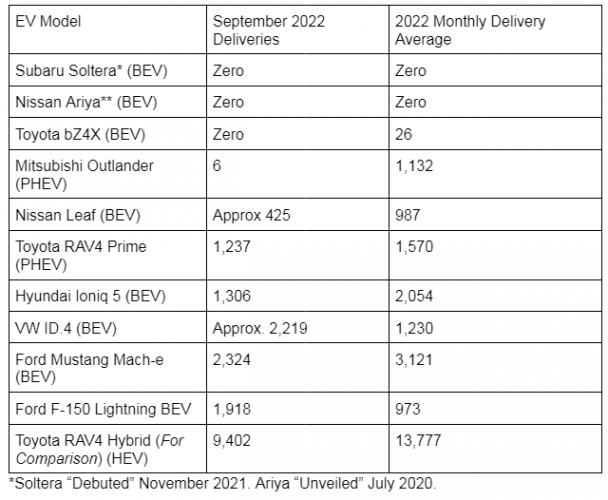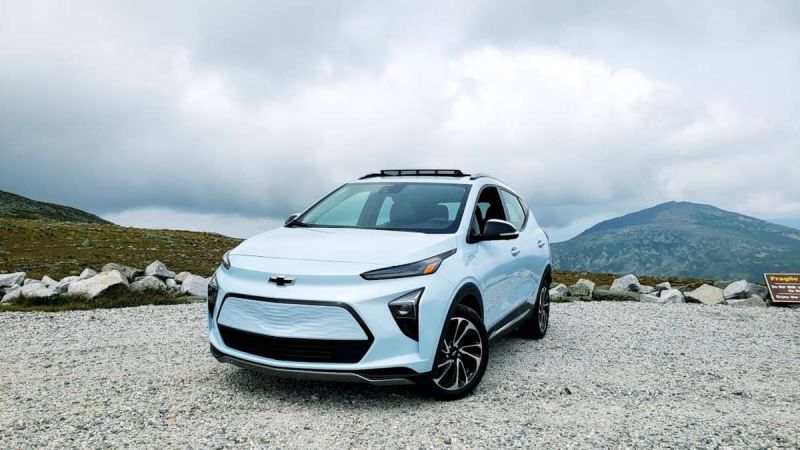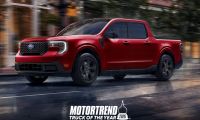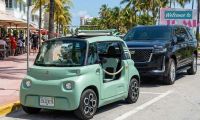Battery-electric vehicles will be mandated by government fiat in just a handful of years. Now that our nation’s capital, California, has dictated that EVs will be the law of the land by 2035, manufacturers will be forced to rapidly ramp the delivery of EVs to consumers. At the present, however, most affordable battery-electric vehicle models are declining in deliveries, not increasing.
Related Story (2022): Europe’s Most Populous City Has Virtually No Electric Vehicles
We have created the below chart to illustrate that many of America’s most popular EV models sold at a lower number In September than their 12-month averages. Most of these models are very new, so a comparison to their prior delivery rates isn’t a simple thing. If a model is missing from our chart, like the Bolt, Niro EV, or Kia EV6, you can assume that the manufacturer did not release monthly and quarterly delivery numbers for the U.S. market broken out by the individual models. Tesla never does so, and Tesla’s vehicles are not in the affordable segment, but rather, are premium-priced. Tesla continues to be a ray of hope in a gloomy EV picture, but for now, only sells pricey models out of reach for many familes.

Why Affordable EV Deliveries Are Declining
The shortages of many components is a factor in why all new vehicle deliveries have been slowed. However, let’s also remember that many of the affordable BEVs on our list were released after the shortages began. Therefore, shouldn’t automakers have already pre-planned the supply chain to build the BEVs they constantly point to as success stories? Most affordable BEVs are all-new models with all-new supply chains. Yet, they are still in decline. And shouldn’t automakers be prioritizing their newest and hottest vehicles if things like chips must be rationed? Why haven’t automakers poured all of their available resources into EVs, given that they are often the fastest-selling models in the lineup?
The Self-Imposed 2,000-Unit Per Month Affordable BEV Delivery Cap
Since the modern age of battery-electric vehicles began in 2010 with the introduction of the Nissan Leaf, manufacturers seem to have self-imposed a 2,000-per-month average delivery cap on affordable BEVs.
Look back over the past 13 years, and you will see that the Leaf, Bolt, Niro, Ioniq, EV6, bZ4X, and even the Mustang Mach-e generally average less than 25,000 units per year in delivery. They do sometimes rise to higher delivery rates. For example, the Bolt has had many months higher than 2,000 units delivered. But they also have periods of far less delivery volume. Sadly, the Bolt just emerged from a year of what seems to be negative deliveries (more were bought back than sold).
It is almost as if automakers pre-plan the BEVs they produce to maximize news headlines but minimize damage to the financial bottom line by not building “too many.” 2,000 units per month seems to be the magic balance. For those readers who don't track monthly delivery numbers, top-selling affordable cars and SUVs are usually measured in the tens of thousands per month of deliveries, with a pre-COVID volume of around 35,000 units per month or more being typical for a top-selling model like the RAV4 or Honda Civic. There has never been an affordably-priced EV that sold in mainstream numbers in America.
It’s Always Tomorrow For Affordable BEVs
Where are the high-volume EVs that most Americans can afford? We hear about EVs many years before they arrive, and the automotive media play along as if the vehicles are actually on sale. Use your browser to search for the Chevrolet Equinox EV and see what we mean. The vehicle is being called a game-changer, but nobody has driven it, none have been sold, and the price estimates are ridiculously low. Particularly since by the time this new BEV arrives, the dollar will have lost another 10% or 20% of its buying power. Need another example? Try searching for the Tesla Model 2.
Who Leads In Affordable EVs Today?
The definition of leadership and affordable are up for debate, but we know a few things for certain. A $70K five-passenger crossover is not what most folks call “affordable.” So Tesla is hard to call the leader in affordable EVs. "Leading" means that the company is demonstrating a path forward. Both GM and Ford can be called leaders in this regard. GM’s Bolt line is fantastic and affordable. And better yet, back on the market after a long span of being pulled from sale. The Ford Mustang Mach-e is the only "affordable EV" we know of today that is being delivered at a rate above 2,000 units per month on average. Only Ford has delivered an EV truck one can call affordable without being cheeky, though it has thus far only been delivered in tiny numbers.
Who Is Not Leading In Affordable EVs?
Who is not a leader in battery-electric vehicles today? Surprisingly, Toyota. The world's leading automaker of green vehicles began delivering battery-electric crossovers to U.S. customers in 1997. Thus far in 2022, it has delivered just 232. Nissan is also not a current leader, despite being credited with creating the first modern-generation affordable BEV, the Leaf almost 12 years ago. Nissan delivered over 2,500 Leafs in December of 2013. In the first three months of this year, Nissan delivered about 1,300 leafs.
Will the “Biden” EV Tax Subsidy Plan Increase EV Deliveries Ahead?
Following President Biden’s leadership on the issue, Congress changed the EV tax credit law this past quarter. While some EV fans see a bright future in the new subsidies, the old plan signed into law by both a Republican and a Democratic President included more electric vehicles. At least in the short term, the new tax law is widely seen as hurting the EV consumer by reducing the number of models covered by the subsidies. At the end of the day, who cares? EVs are flying off lots with huge dealer markups. If subsidies can somehow convince automakers to build more EVs that will be great, but we have had green vehicle subsidies for three decades now.
Related Story: 4 Presidents Later, Buyers Don’t Know How Federal EV Tax Incentives Work
Don’t Kill the Messenger
Stories reporting the truth about EVs are often seen by many EV advocates as anti-EV. Perhaps some are, but shouldn’t the truth set us free? Free from unreasonable expectations? Free from disappointment when one shops for a $39,000 Ford F-150 Lightning only to find that the price is actually more like $54K and the vehicle is not even for sale? Free from the expectation that a tax break will help make EVs more affordable, only to find that dealers have marked the vehicle up above the MSRP by more than the tax break? Tell us your thoughts in the comments below.
John Goreham is a long-time New England Motor Press Association member and recovering engineer. John's interest in EVs goes back to 1990 when he designed the thermal control system for an EV battery as part of an academic team. After earning his mechanical engineering degree, John completed a marketing program at Northeastern University and worked with automotive component manufacturers, in the semiconductor industry, and in biotech. In addition to Torque News, John's work has appeared in print in dozens of American news outlets and he provides reviews to many vehicle shopping sites. You can follow John on TikTok @ToknCars, on Twitter, and view his credentials at Linkedin
Re-Publication. If you wish to re-use this content, please contact Torque News for terms and conditions.
Image of 2022 Chevrolet Bolt EV on mountain by John Goreham












Comments
I would have bought a Volt
Permalink
I would have bought a Volt and a Bolt if they had been AWD. I remember going to Cobo and seeing the Volt prototypes for multiple years before it actually came out, but then it was too expensive for me so I got a Prius for gas savings and a Jeep for getting through the snow (and fun off-road). For me, everything has to compare with Subaru AWD now and that's tough to beat. I've got a Solterra on order (if the market turns around a bit by next year when they start getting delivered), a Blazer EV reserved (for when I have to pass on the Solterra), and I'm really hoping the Equinox EV is affordable, has enough space, and good AWD. The biggest issue is not being able to see any of these things to determine whether they're going to be a suitable vehicle aesthetically and practically.
Very interesting. I have
Permalink
In reply to I would have bought a Volt by jg (not verified)
Very interesting. I have written about the lack of affordable BEV crossovers and the stories didn't get much traction. Seems to me that AWD and a spare tire are just basic equipment in anything that might be called a "Utility Vehicle." Good luck with the Soltera. I'm a 4-time Subaru owner and the only thing I don't like about my current Forester is the powertrain. It's downright awful. I'm ready for a PHEV or BEV Forester right now.
I'm anticipating a single
Permalink
In reply to Very interesting. I have by John Goreham
I'm anticipating a single test drive in the Solterra then walking away -- it's WAY too much Toyota and sadly not much Subaru. From many online reviews, I think they did fantastic on the drivetrain but you still have to look at it and live with the interior, and I have a REALLY hard time paying Toyota a few hundred dollars a year just to get rid of the "Subscribe" nag screen on the huge center display. As far as Subaru's go, I've purchased 12 and the 2.5 that went into the 2019 and above Forester is a fantastic little engine. I even like it more than the turbo in the Forester XT, which was traded in on the 2019. For power, I still have my 2018 Outback Touring 3.6 and am eagerly awaiting a BEV version.
Tesla's total 2022 sales
Permalink
Tesla's total 2022 sales (customer deliveries) amounted to 343,830 (up 42% year-over-year), which is a new all-time record for Tesla. You may not consider Tesla's affordable, but all of those thousands of buyers would disagree with you. GM just announced that their Bolt/EUV orders have now surpassed their ability to build them fast enough to meet demand. And even those orders were slowed because prospective buyers were waiting for both the $6,000 price drop for 2023 models, and the upcoming federal subsidies. Admittedly, many models will not qualify for the new subsidies. But for Chevy and Tesla, any new money will be a welcome change from zero subsidies that they had been getting previously. These lackluster numbers relate more to production limitations than to the ever increasing EV demand issues.
Absolutely right about the
Permalink
In reply to Tesla's total 2022 sales by DeanMcManis (not verified)
Absolutely right about the slowing deliveries being production-related. 100% delivery related in my estimation. I'm super careful in all my stories never to imply that buyer demand is limiting EVs, because clearly, it is not. Do most Tesla buyers who pay, let's say, $70K for a five-passenger crossover really think they are buying what most folks would consider an "affordable" crossover? That would truly surprise me. In the home real estate market, I don't think folks who buy $1m dollar homes consider the home "Affordable Housing." I'm looking for a better word for affordable, but mainstream is not really right either. Suggestions? Thanks for taking time to read and post.
You might qualify the lowest
Permalink
You might qualify the lowest priced and name it as Entry level EVs. Or more generally Average Priced vehicles. In the U.S. The average price of a new vehicle in the U.S. is just over $48K today, and the average price of an EV today is $66K before subsidies. But that is skewed because many of the EVs today are higher end vehicles. The 2024 Chevy Equinox will probably replace the Bolt/EUV as GM's lower priced entry into EVs.
I've wondered about the
Permalink
I've wondered about the apparent love affair between car review publications and generally unaffordable high-end EVs and gas burners. Could the distorted focus on low volume luxury vehicles be sparked by gifts and loans of such vehicles to the lucky test drivers and publishers? Who wants to test drive a Leaf when you could be cruising around in a BMW? Too cynical?